brakes BUICK ROADMASTER 1993 Owners Manual
[x] Cancel search | Manufacturer: BUICK, Model Year: 1993, Model line: ROADMASTER, Model: BUICK ROADMASTER 1993Pages: 340, PDF Size: 18.34 MB
Page 82 of 340
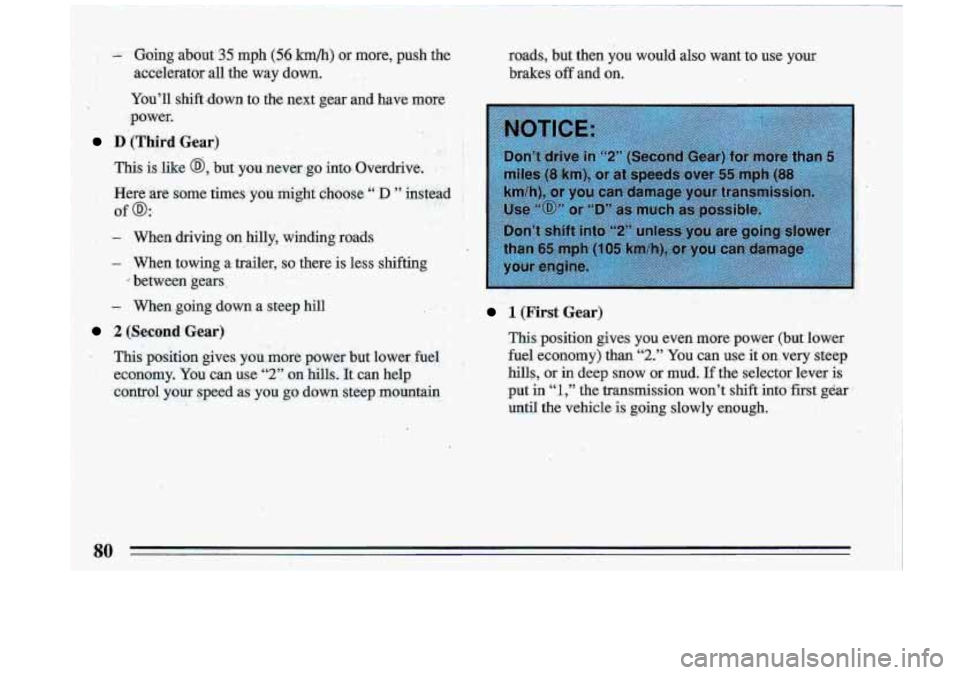
-. Going,about 35 mph (-5.6 km/h) or more, push the
accelerator all the way do.wn.
. .
You’ll shift,down to the next gear and have more
power.
D.(Third Gear)
This is like @, but you never.go into-Overdrive. - .
Here ’ue some tirnes kowmight dboose “ D ” instiad
of a:. -,
.. - When driving on hilly, winding roads
- When towing a- trailer, so there is less shifting
- When .going down a steep hill . . . !A
J between gears.
2 (Second Gear)
. This position gives you.more ,power but lower fuel
ecanomy. You can use
“2’’ on hills..Zt can help
cohtrol your
speed as. you go down steep mountain roads, but
then-you would also want
to use your
brakes
off and on.
1 (First Gear)
This position gives you even more power (but lower.
fuel economy) than
“2.” YOU can use it on,very steep
hills, or in deep snow or mud.
If the selector lever is
put in
“1,” the transmission won’t shift into first gear
until the vehicle is going slowly enough.
Page 96 of 340
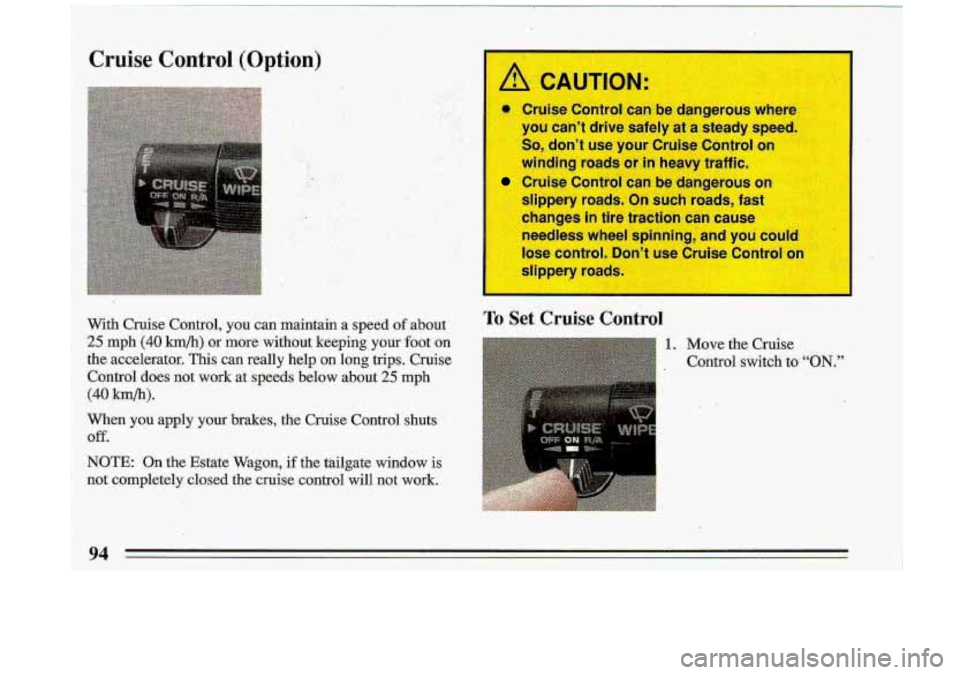
Cruise Control (Option) ,* .. :. .> ..
..
";. ?y . ..
I you can't drive safely at a steady speed.
So, don't use your Cruise Control on
winding roads or
in heavy traff'
Cruise Control can be dangerous
slippery roads. On such roads, fast
changes in tire traction can cause
needless wheel spinning, and you
COI
lose control. C tt I ~ = P ise ^ontrol on
I
lippel- poads
With Cruise Control, you can maintain a speed of about To Set. Cruise Cc-trol
25 mph (40 km/h) or more without keeping your foot on 1. Move the Cruise
the accelerator. This can really help on long trips. Cruise Co\
ntrol switch 'to
"ON."
Control does not work at speeds below about 25 mph ;.'
When you apply your brakes, the Cruise Control shuts i. 'I
.Off.
NOTE: On the Estate Wagon, if the tailgate window is
not completely closed the cruise control will not work.
(40 k-yn/h).
Page 123 of 340
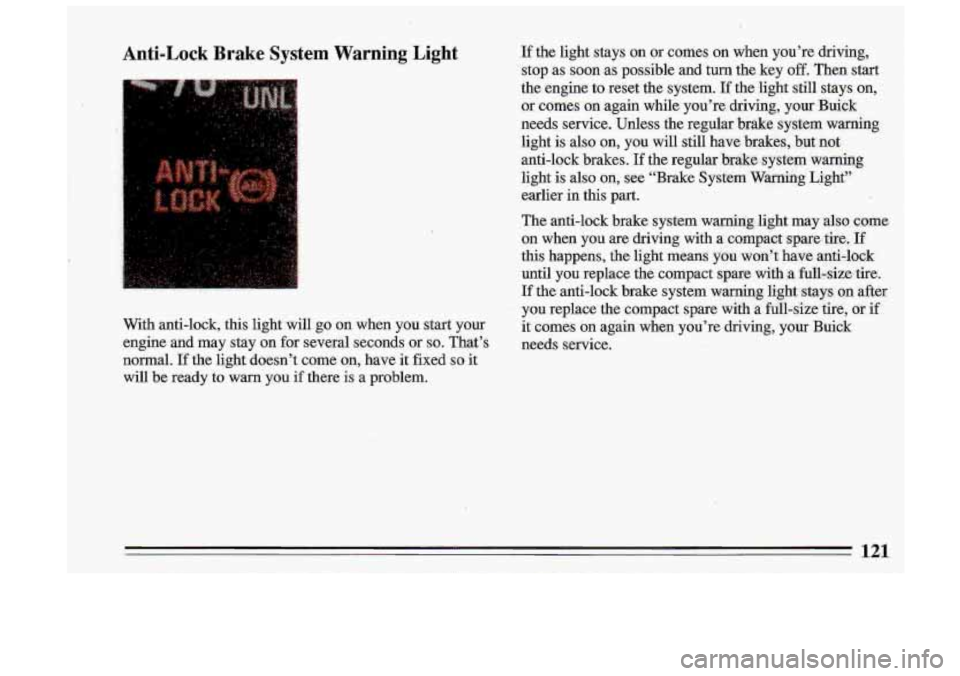
iI
Anti-Lock Brake System Warning Light
. -, i’
.. I. ,:,:
With anti-lock, this light will go on when you start your
engine and may stay on for several seconds or
so. That’s
normal.
If the light doesn’t come on, have it fixed so it
will be ready to warn you if there is a problem.
If the light stays on or comes on when you’re driving,
stop as soon as possible and turn the key
off. Then start
the engine to reset the system.
If the light still stays on,
or comes on again while you’re driving, your Buiek
needs service. Unless the regular ‘brake system warning
light is also
on, you will still have brakes, but not
anti-lock brakes.
If the regular brake system warning
light is also
on, see “Brake System Warning Light”
earlier
in this part.
The anti-lock brake system warning .light may also come
on when you are driving with
a compact spare. tire, If
this happens, the light means you won’t have anti-lo,ck
until you replace the compact spare ,with
.a fuU-simtire.
If the anti-lock brake system warning light stays
on after
you replace the compact spare with a full-size tire, or if
it comes
on again when you’re driving, your Buick
needs service.
121
Page 165 of 340
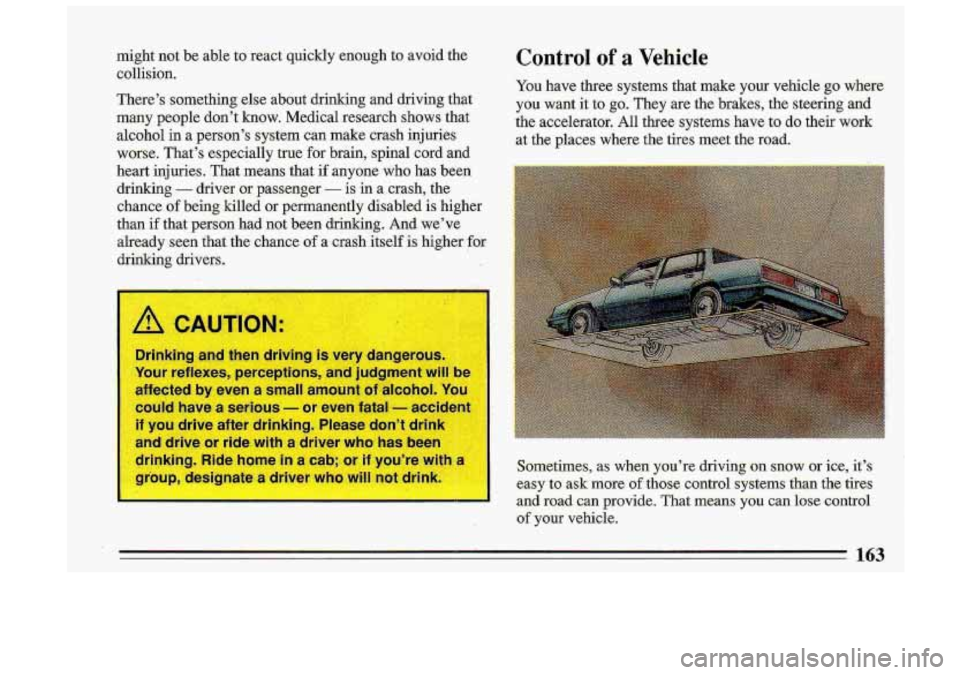
might not be able to react quickly enough to avoid the
collision.
There’s something else about drinking and driving that
many people don’t know. Medical research shows that
alcohol in a person’s system can make crash injuries worse. That’s especially true for brain, spinal cord and
heart injuries. That means that
if anyone who has been
drinking
- driver or passenger - is in a crash, the
chance of being killed or permanently disabled is higher
than
if that person had not been drinking. And we’ve
already-seen that the chance
of a crash itself is higher for
drinking drivers.
1- -
/q CAUTION:
Drinking and then driving is very dangerous.
Your reflexes, perceptions, and judgment
will be
affected by even a small amount
04 alcohol. You
could have a serious - or even fatall - accident
if you drive after drinking. Please don’t drink
and drive or ride with a driver who has been
drinking. Ride home
in a cab; or if you’re with a
group, designate a driver who will not drink.
Control of a Vehicle
You have three systems that make your vehicle go where
you want it to
go. They are the brakes, the steering and
the accelerator. All three systems have to
do their work
at the places where the tires meet the road.
Sometimes, as
when you’re driving on snow or ice, it’s
easy to ask more of those control systems than the tires
and road
can provide. That means you can lose control
of your vehicle.
163
Page 166 of 340
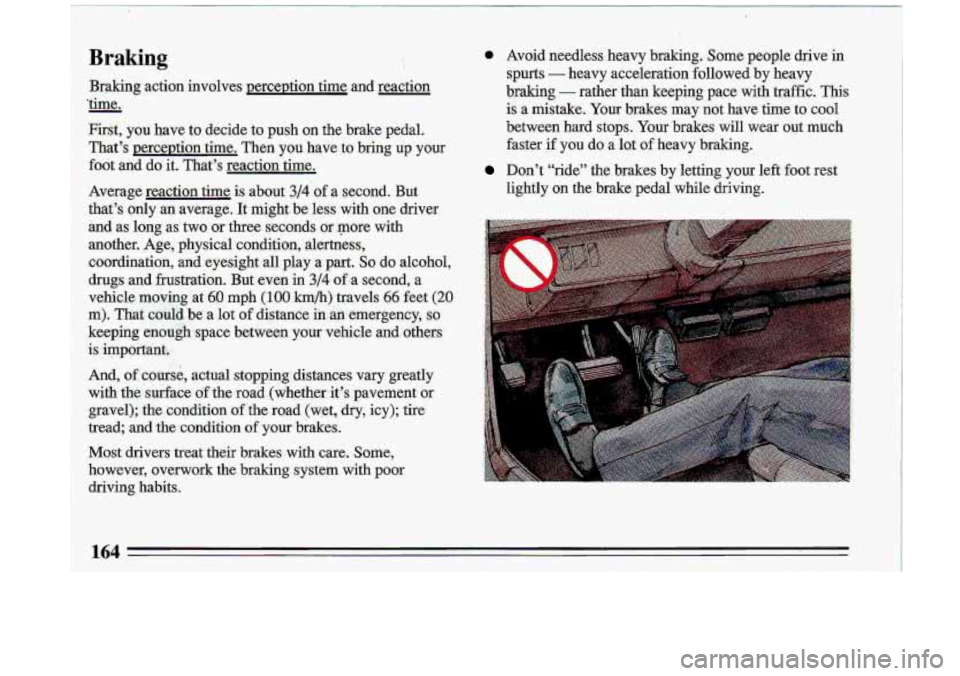
Braking
Braking action- involves perceDtion time and reaction
’time.
First, you have to decide to push on the brake pedal.
That’s perception time. Then -you have to bring
up your
foot and do it. That’s reaction-time.
-
Average reaction time is about 314 ‘of a second. But
that’s only -an average. It might be less with one driver
and as
long as two or.three seconds or .more with
another.
drugs and frustration. .But even in
3/4 0f.a second, a
vehicle moving at
60 mph (1 00 h/h) travels 66 feet: (20
m). That could. be a lot of distance in an-emergency, so
keeping enough- space between your vehicle and-others
is important.
And, of course, actual stopping distances vary greatly
with the saiface- of the raad.(whether it’s pavement or
gavel); the condition of the road (wFt, dry, icy); tire
tread; and
the condition of your brakes.
Most -drivers treat their brakes with care. Some,
however; overwork the braking system with poor
driving habits.
* Avoid needless heavy braking. Some people drive in spurts
- heavy acceleration followed by heavy
braking
- rather than keeping pace with traffic. This
is a mistake. Your brakes may not have time to cool
between hard stops. Your brakes will wear out much faster if you do a lat of heavy braking.
Don’t “ride” the brakes by letting your left foot rest
lightly on the brake pedal while driving.
Page 167 of 340
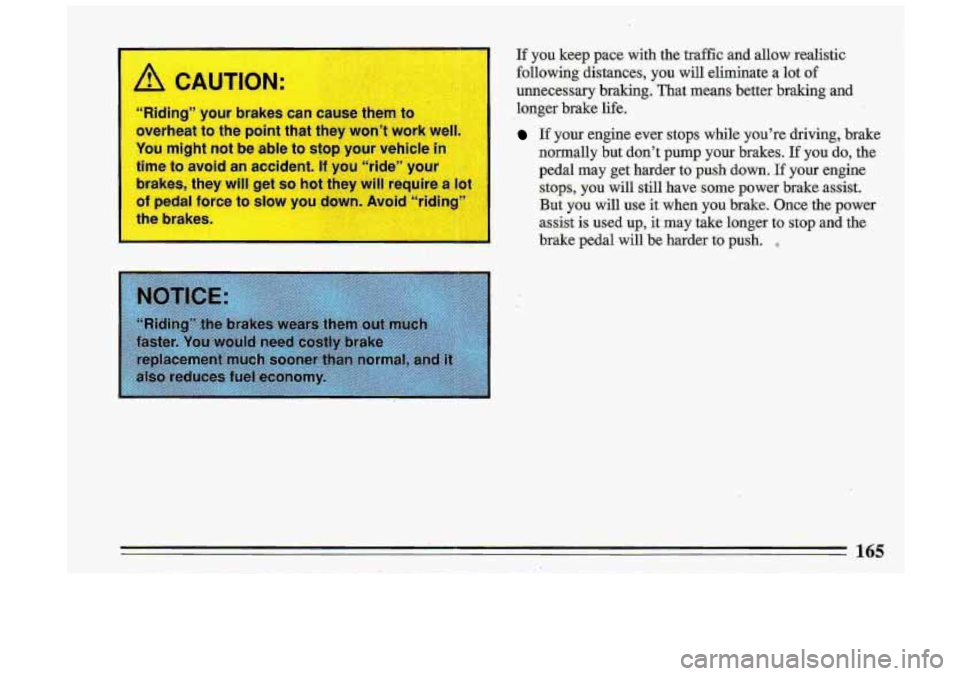
Riding” your brake
overheat to the point that they won’t work well,
You might not be able to stop your vehicle
it
time to avoid an accident. If you “ride” your
brakes, they will get
so hot they will require a 1st
of pedal force to slow you down. Avoid “ridil
the brakes.
If you keep pace with the traffic and al1,ow realistic
followirig distance.s, you will eliminate a lot
of
unnecessary braking. ‘That means better braking and
longer brake
life.
If your engine ever stops while you’re driving, brake
normally .but don’t
pump your brakes. If you do, the
pedal may get harder to push down.
If your engine
stops, you will still have some power brake. assist.
But you will use it when you brake. Once.the power
assist
is used up, it-may take longer to stop and the
brake pedal
will be harder to push.
165
Page 170 of 340
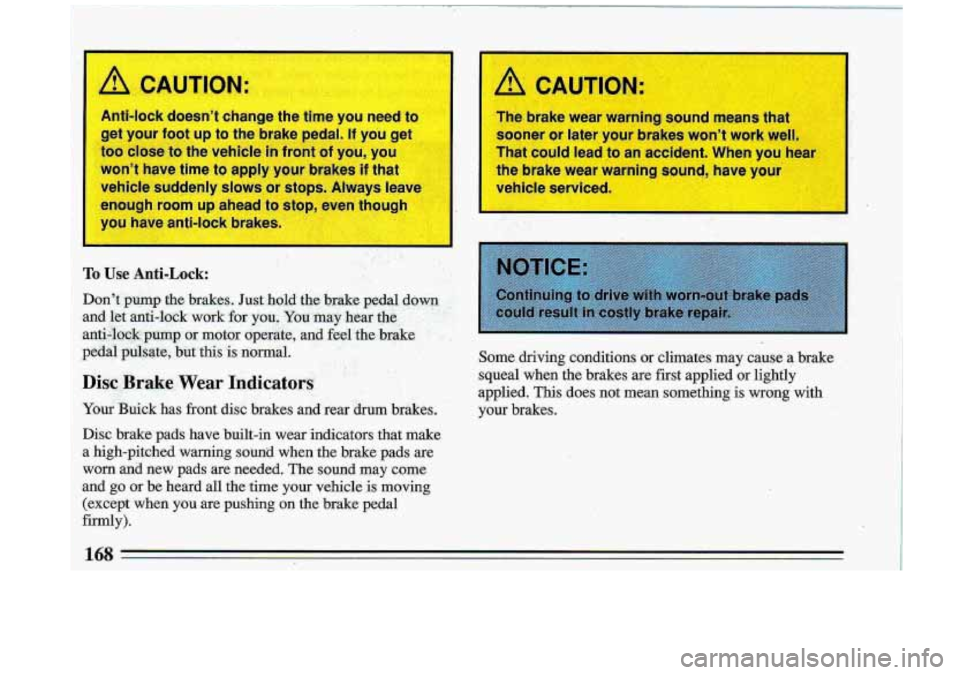
I
1 /! CAUTION: A CAUTION:
The brake wear warn g s
sooner or later your brakes won’t work well
That could lead
to an accident. When you hear
the brake wear warning
-- -3 your
vehicle serviced. -. --I - ,~
I
Some driving conditions or climates may cause a brake
squeal when the brakes are first applied or lightly
applied. This
does not mean something is wrong with
your brakes.
Page 171 of 340
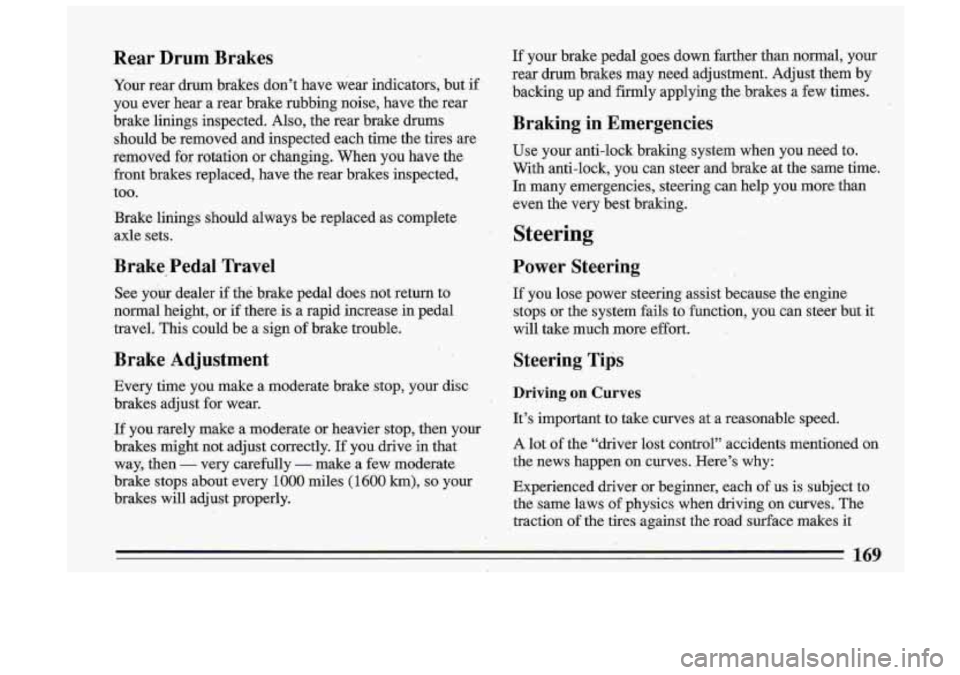
If your brake pedal goes down farther man normal, your
rear drum brakes may need adjustment. Adjust them by
backing
up and firmly applying the brakes a few times.
I
Braking in Emergencies I
Use your anti-lock braking sysKem when you need to. .
With anti-lock, you can steer and brake at the same time.
In many emergencies, steering can help you .more. than
even the very best braking.
Steering
Power Steering
If you lose power steering a ssist becau Lse
the engine
stops or the system fails to function, you can steer but
it
will take much more effort.
Steering Tips
Driving on Curves
It’s important to take- curves at a reasonable speed.
A lot of the “driver lost control” accidents mentioned on
the news happen on curves. Here’s why:
Experienced driver or beginner, each
of us is subject to
the same laws of physics. when driviqg on curves. The
traction
of the tires agairist the road s.urface makes it
169
Page 172 of 340
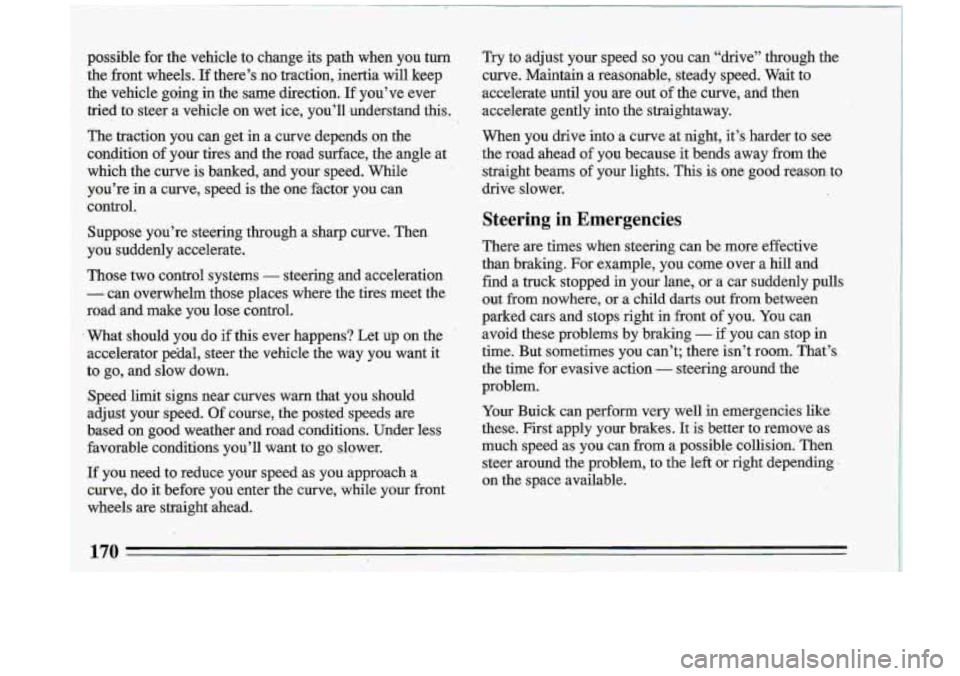
Try to adjust‘ your speed so you can “drive” through the
curve. Maintain a reasonable, steady speed. Wait to
accelerate until you are out
of the curve, and then
accelerate gently
into the straightaway.
When you drive into a curve at night, it’s harder to see
the road ahead
of you because it bends away from the
straight beams
of your lights. This is one good reason. to
drive slower.
Steering in Emergencies
There are times when steering can be more effective
than braking. For example, you come over a hill and
find a truck stopped
in your lane, or a car suddenly pulls
out
f-rom nowhere, or a child darts out from between
parked
cars and stops right in front of you. You can
avoid these problems by braking
- if you can stop in
time. But sometimes you can’t; there isn’t room. That’s\
the time for evasive action
- steering around the
problem.
Your Buick can perform very well in emergencies like
these. First apply your brakes. It is better to remove as
much speed as you can
from a possible collision. Then
steer around the problem, to the left
or right depending
on the space available,
Page 180 of 340

The heavier the rain, the harder it is to see. nven if your
windshield wiper blades are in good shape, a heavy rain
,can make it harder to see road signs and traffid. signals, .
pavement markings, the edge of the road, and even
people walking. Road spray can often be worse for
vision than rain, especially if it
comes frum a dirty road.
So it is wise to keep your wiping equipment in good i.
shape and :keep your windshieklwasher tank filled.
Replace
your windshield' wiper inserts when 'they' show
signs
.of streaking-or missing areas on the windshield, or
when strips
of rubber start to separate from the inserts. Driving,
too fast through large water puddles or even
going through some car washes can cause problems,
too.
The water may affect your brakes. Try to avoid puddles.
But
if you can't, try to slow down before you hit them.
A I
,A CA JTION:
Wet brakes can cause accidents. They won't
work well in a quick stop and may cause pl ng
to one side.
Yo Zould lo! eo - *oI of -- 3
vehicle.
After driving thro
-=-- -i la.,e p-Jdle 0. ,later
a car wash, apply your brake aedal liahtly unt
1 Iur brakes work normal
178